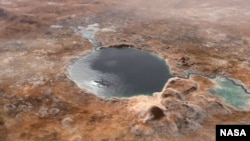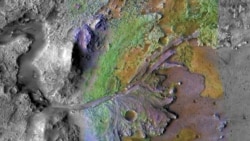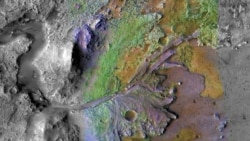American researchers say they have invented a method that could use salty water on Mars to produce oxygen and fuel.
Oxygen and fuel would both be important elements to support future human exploration activities on the Red Planet.
Engineers at Washington University in St. Louis, Missouri, developed the new method. The method operates with electrolysis, a process that passes an electrical current through liquid, such as water.
The machine the researchers created is called an electrolyzer. The researchers say it can separate salty water into oxygen and hydrogen gases. Oxygen would be needed for humans to breathe and hydrogen could be used to fuel spacecrafts and equipment.
The team described the process in a study recently published in Proceedings of the National Academy of Sciences (PNAS).
Scientists have already collected solid evidence suggesting that Mars once had huge amounts of water and that the planet likely holds a large supply today. But Mars is extremely cold. So, most of the water is thought to exist in the form of ice.
The research team notes that any water that is not frozen is almost surely full of salt from the Martian soil. The usual electrolysis methods for breaking water down into oxygen require the salt to be removed first. This process can be complex, costly and harmful to the environment, the researchers say.
They said the new method they invented can take salty water directly and convert it into oxygen and hydrogen.
The team carried out experiments with high levels of magnesium salts, which scientists believe likely exist on Mars. The researchers also carried out the tests at temperatures similar to the Red Planet’s atmosphere.
In a news release, the engineers suggested that the system would be highly valuable during planned exploration activities on Mars. “In order to live - even temporarily - on Mars, not to mention to return to Earth, astronauts will need to manufacture some of the necessities, including water and fuel, on the Red Planet.”
The U.S. space agency NASA has also experimented with technology to produce oxygen on Mars. One device designed to do this will be tested as part of NASA’s Perseverance mission. Perseverance is a new explorer vehicle, or rover, that is currently on its way to Mars.
The NASA device is designed to convert carbon dioxide from the Mars atmosphere into oxygen. The process uses a high-temperature electrolysis method. NASA scientists have tested the system by recreating the Mars atmosphere in experiments on Earth.
The lead researcher on the new project is Vijay Ramani, a professor of chemical engineering at Washington University. He said the system his team developed could produce 25 times more oxygen than the NASA method, while using the same amount of power. It can also produce hydrogen fuel, which the NASA device cannot.
The engineering team said its method could even find valuable uses on Earth. “Having demonstrated these electrolyzers under demanding Martian conditions, we intend to also deploy them under much milder conditions on Earth,” said Pralay Gayen. He is a postdoctoral researcher at Washington University and a lead writer of the study.
Gayen said the device could possibly be used to convert brackish or salt water into oxygen and hydrogen through “seawater electrolysis.”
Once such use could be in defense industries, he added. The method could create oxygen on demand for submarines. It may also be able to provide oxygen to researchers exploring new environments in the deep sea.
I’m Bryan Lynn.
Bryan Lynn wrote this story for VOA Learning English, based on reports from Washington University, Nature and PNAS. Ashley Thompson was the editor.
We want to hear from you. Write to us in the Comments Section, and visit our Facebook page.
_______________________________________________________________
Words in This Story
convert – v. to change the appearance or purpose of something
mention – v. to speak about something quickly, with little detail or using few words
mission – n. an important task, usually involving travel somewhere
brackish – adj. water that can be slightly salty, dirty and unpleasant











